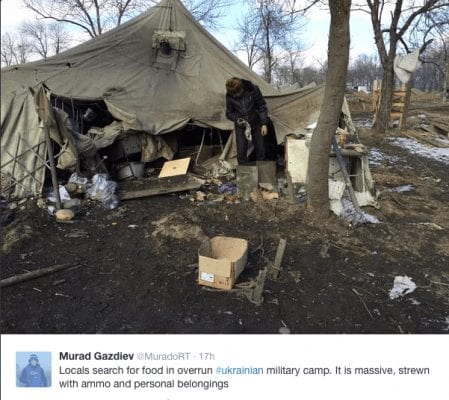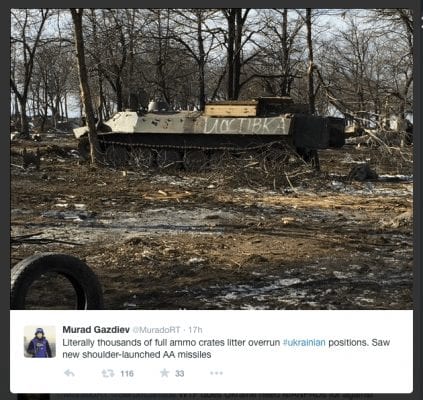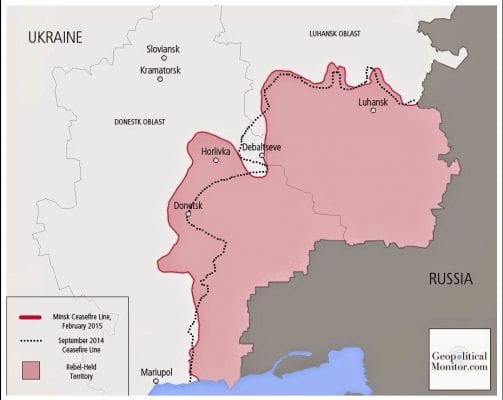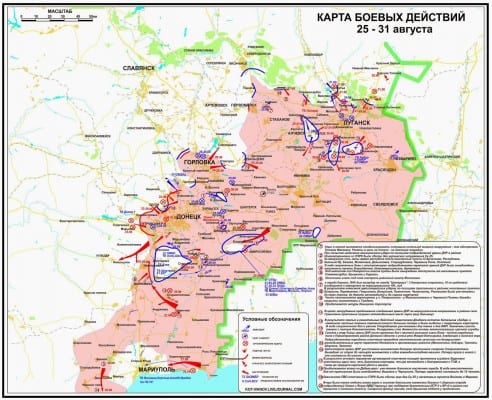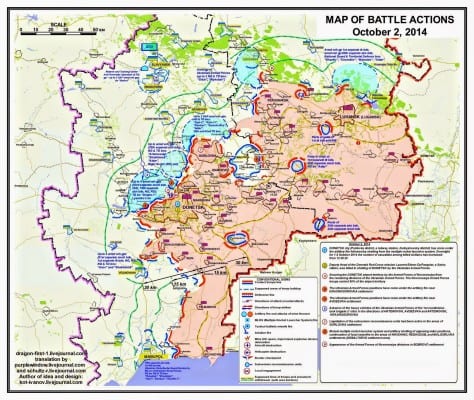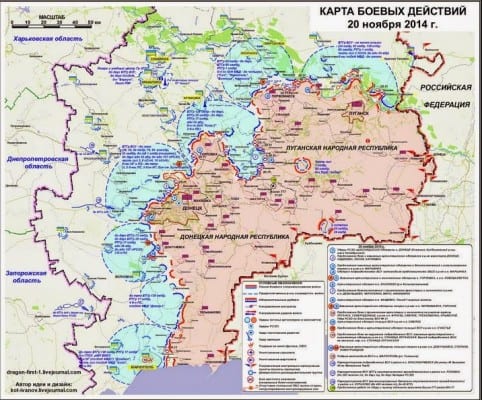The Beautiful Truth about Minsk II & The Debaltsevo Debacle
Joaquin Flores
BELOW: Victorious Novorussia fighters atop armored vehicle. 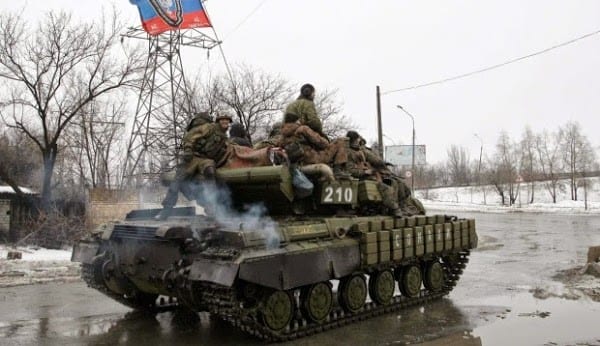
[dropcap]O[/dropcap]n February 12th, on the day Minsk II was signed by the contact group as agreed to by the Normandy 4, we wrote:
“These are the relevant factors which produce the strong sense that these Normandy 4 meetings involve some very serious things and some complex levels that are beyond the scope of what is reported. Russia conducts itself in these meetings from a position of strength.”
Ukrainian tank operating in Delbatsevo area. Their hasty retreat has presented Potroshenko and his Western patrons with an almost impossible political and strategic dilemma.
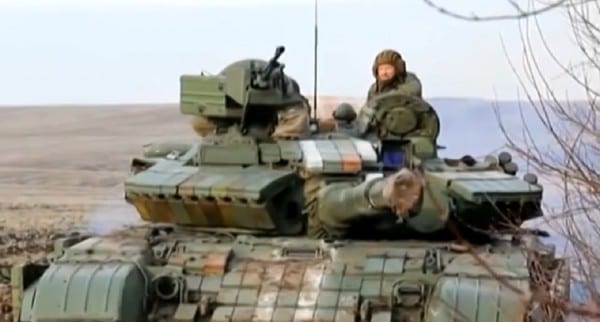
Critical events since the February 12th ceasefire show us the real underlying factors beyond the scope of what was originally reported. With the Ukrainian Army (UAF) having been encircled in the Debaltsevo region—caught in a “cauldron”— and without provisions, mass surrenders are already underway. There are reports of thousands of UAF dead. Close fighting in the town itself have resulted in the UAF being pushed out, with the town now under Novorossiyan control. The UAF had nowhere to go, and were out of ammo.
Attempts to push out anywhere resulted in more needless deaths for the disheartened and broken Ukrainian force whose numbers range between five and eight thousand. Putin has publicly urged Poroshenko to allow the UAF soldiers to surrender. Unsurprisingly, Poroshenko has declared victory.
NAF’s spoils of war: quite a trove of first-class war materiel. High-tech weapons can never substitute for morale, nonetheless, as the fighting in Eastern Ukraine has proved time and again.
The encirclement was complete in the week leading up to the Minsk II meeting. The political reality in which the EU gave its blessing to Novorossiya and Russia to finish off the encirclement was based in a few things, and US agreement to other points was based on other considerations. There are three sides at play here, even though it often appears as two. The Minsk II agreement enshrined the EU blessings. In return, the EU got something, but what that is remains the subject of some speculation.
Debaltsevo is a critical area because it has rail lines through it which connect the Lughansk and Donetsk republics. The September 5th Ceasefire was intended to have this in control of Novorossiya. The September 19th memorandum explicitly restates this, and the map of the de-militarized and pull-back lines clearly show that Debaltsevo was to be withdrawn from.
Poroshenko stated that the Cauldron was actually a bridgehead. In fact, he is right, this was not a new development but an ongoing occupation of Debaltsevo which was in violation of the 9-19 memorandum.
Overall, this agreement is reflective of the general direction things have gone, and reflects Russian mastery of geopolitical strategy, meaningful diplomacy and “lawfare”, hybrid warfare, and thorough planning all around.
Kiev’s sudden military collapse can be appreciated in these shots of an abandoned camp. As noted above, enormous quantities of ammo and other supplies were found by the NAF fighters. (Mural Gazdiev)
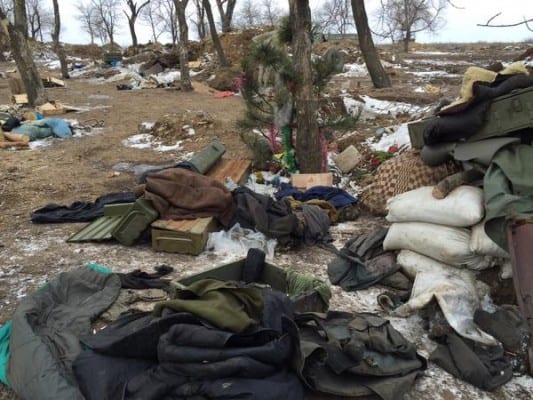
Why Debaltsevo was an apparent exception to the ceasefire, what the new ceasefire agreement actually compels, what was really said at Minsk, what to make of the UN Security Council resolution, and what this says about the present state of affairs are all serious questions that are raised from the recent developments. These are the pressing questions we will try to answer in brief.
1) The EU was forced to agree to a revised form of the September ceasefire, including the memorandum of the 19th of that month. US policy is failing, or rather succeeding in producing an unstable situation, precisely what most of European decision makers want to avoid. Even EU Atlanticists are not in it for the whole wild ride, and their Trans-Atlantic sensibilities are still based upon general notions of wealth creation and regional stability.
Evidence of this was the impending doom of thousands of UAF fighters, as leaked information indicated a number of these may be from NATO countries, and Merkel and Hollande were right in knowing that they had better get clarification on this matter directly from the Russian head of state.
Indeed, this is why European leaders called the meeting, and rushed to Minsk.
Poroshenko does not answer to the EU, they are not his guarantor, and they are not capable of pressuring him too much. They can only pressure the US, and only by extension Poroshenko, by not going along with US plans for Russia and Ukraine. EU has said no to Ukraine in NATO, and no to the EU Association Agreement after all. On these critical points the EU says, over and over, the same thing that Russia says.
BELOW: Poster satirizing Poroshenko’s actual position in the geostrategic mix.
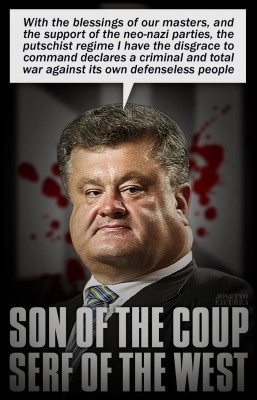 To understand the Minsk agreement is to understand the EU’s relationship with the Kiev Junta. The EU knows that when it talks to Poroshenko, it is talking to a US sock puppet. The reason that Poroshenko was at the meeting, and not the US, was because the EU and Russia wanted to tell Poroshenko certain things in a security environment which only the nominally neutral Minsk could provide. No one really thinks that Belarus is neutral, but everyone can pretend that they are.
To understand the Minsk agreement is to understand the EU’s relationship with the Kiev Junta. The EU knows that when it talks to Poroshenko, it is talking to a US sock puppet. The reason that Poroshenko was at the meeting, and not the US, was because the EU and Russia wanted to tell Poroshenko certain things in a security environment which only the nominally neutral Minsk could provide. No one really thinks that Belarus is neutral, but everyone can pretend that they are.
The EU generally is not happy with how the US has handled things, and yet it is straddling two chairs on the question. So this is about the US using its pull on the Atlanticist forces within the EU, and also within less formal NATO structures, to make a policy for Europe and on Europe outside of the scope of European agency.
The prior agreement among other things specifically placed control of Debaltsevo in the hands of Novorossiya. Both the September and February agreements contain some apparent defects, which work out favorably again for the Russians. This is why we have heard rebel commanders and DPR leader Zakharchenko affirm both that the agreement is vague and contains contradictions, and also that Debaltsevo was not included in the ceasefire. Rather, he means the opposite on these points.
First, the terms are vague and do not compel the rebels to end the rebellion (it places the onus on Ukraine to do things first that it will never do, and is not compelled to do by the language). Second, abiding by the ceasefire, it entirely justifies the use of arms to resolve the UAF’s violation of the agreement through its intrusion into the Debaltsevo area. At least on paper, it boils down to how one interprets specific language from the Minsk II agreement of February 12th. We will look at this in a moment.
The map below includes the September 19th line as a dotted black curving series of dots, which have Debaltsevo on the Novorossiyan side of the line. There are at least two ways to interpret the language of the latest agreement.
In Alexander Zakharenko, young Novorossiya has a leader that fuses Jefferson’s intellectual gifts with George Washington’s courage and military skill. (Screen grab)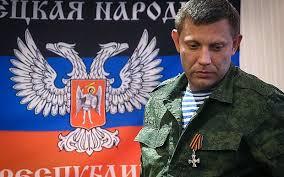
What will figure prominently in the coming disagreements over implementation is the meaning of point 2 and point 4. The Minsk II agreement of February 12th refers back to the Minsk Memorandum of 19th September twice. These are in relation to the borders, one way or another, of Novorossiya.
In point 2 we read:
- Pull-out of all heavy weapons by both sides to equal distance with the aim of creation of a security zone on minimum 50 kilometres (31 mi) apart for artillery of 100mm calibre or more, and a security zone of 70 kilometres (43 mi) for MLRS and 140 kilometres (87 mi) for MLRS Tornado-S, Uragan, Smerch, and Tochka U tactical missile systems:
* for Ukrainian troops, from actual line of contact;
* for armed formations of particular districts of Donetsk and Luhansk oblasts of Ukraine, from the contact line in accordance with the Minsk Memorandum as of 19 September 2014
The pullout of the above-mentioned heavy weapons must start no later than the second day after the start of the ceasefire and finish within 14 days.
This process will be assisted by OSCE with the support of the Trilateral Contact Group.
This refers to artillery pull-out, but note that there are different lines to withdraw from for each of the two sides. This can be interpreted different ways: the word ‘actual’ means ‘in reality’, but which reality – the past, present or the future; the line on the 12th, on the 15th, or 14 days after the 15th? Whatever the case what it does do inarguably is draw us back to the Minsk Memorandum of the 19th and reaffirms those lines. The line for Novorossiya in that 19 September agreement includes Debaltsevo within it.
Without delays, but no later than 30 days from the date of signing of this document, a resolution has to be approved by the Verkhovna Rada of Ukraine, indicating the territory which falls under the special regime in accordance with the law “On temporary Order of Local Self-Governance in Particular Districts of Donetsk and Luhansk Oblasts,” based in the line set up by the Minsk Memorandum as of 19 September 2014. These two cited sections taken together mean that some things in point 2 are obligated to have taken place on or about March 1st, and point 4’s ‘Rada resolution’ must be approved by Ukraine by mid March. But what is approved is a resolution that ‘indicates’ the territory, which is not the same thing as ‘recognizing’ that territory or vesting those local authorities with any specific rights and obligations. In the course of the execution of the September agreement, each side accused the other of having violated it. Over the course of time, with each side making it known to the other, it can reasonably be said that much of it was no longer in effect. With those changes having effectively taken place to the original agreement, references to the Minsk Memorandum of 19 September begin to take on elements of vestigial clauses or vestigial language if they lack meaning or if subsequent practices and events have diminished their effect. While point 2 seems to refer more strongly to the 19 September borders when it constrains the Novorossiyans, in point 4 in which the Ukrainian Rada ‘indicates’ their territory, the language is much softer and states that it be ‘based in’ that line. Other problems in point 4 which may make the entire agreement defective and void notwithstanding (this may relate to the details of the referenced Ukrainian law on local self-governance), we can see clearly that the Rada must ‘indicate’ – which does not carry the force of ‘determine’, and certainly not ‘recognize’. Furthermore it states that the boundaries are ‘based in the line’, not precisely the line determined then, but possible a new line which is ‘based in the line’ in some day – determined by the same rationale, recognizing the same interests, or closely resembling – so it would be argued – the September 19th line in some credible way. It was required, therefore, to agree again on the terms, so that this ‘reset’ supersedes the previous deviations, which if unchallenged may actually establish a new tacit agreement. Even though the references to the September 19th line are not coupled with firm language which compels specific actions coupled with specified consequences for inaction and remedy process, they are still referenced too. This means that parties can justify their ‘ceasefire’ actions of this already confused document as being based on the agreement. Overall, we can see we have drawn several distinct interpretations. One seems to be based in the ‘actual line of contact’ for the Ukraine side, which would be where the UAF positions ‘are’ (but vague about ‘when’ we look). The other one allows us to interpret the language as effectively returning the strategically Debaltsevo region to Novorossiya in accordance with the September 19th agreement. When we look at the following series of situation report maps, September, October, and November, we can see that soon after the September agreement characterized by a Novorossiyan Debaltsevo, the UAF took it in violation of that agreement. Those who have been keeping an eye on these developments during the ‘ceasefire’ months will already appreciate that the encirclement did not form out of a recent advance of the UAF. This was not a blunder that pushed forward too far as a result of poor communication or bad planning. The ‘bridgehead’ it maintained was extraordinarily well fortified. It had intended to be surrounded on three sides and function like a fortification that could tolerate a near-siege. Indeed it was even thought that this bridgehead could become the focus of Novorossiya efforts, wicking them away from elsewhere, and once drawn in and then ground down, the protrusion could push farther south-east. Their strategy has been to develop this cleavage further until they can split Donetsk off from Lugansk entirely.
destabilize the region, but only with a Russian over-commitment which places it on course for its own internal destabilization as well.
A large number of those elites in Europe who are cautiously sitting in two chairs and trying to appease US policy, will only continue to entertain the US course so long as it does not result in further destabilization. In a mid-intensity conflict such as this where the information war is central, it is a poor move to be the party which turns down unconditional overtures for ceasefire talks.
The US thought it was in a ‘win-win’ with this situation.
If on the one hand Poroshenko could get the Russians, in light of the recent advances and the statements from Zakharchenko, to stop the push and return to the September lines, this would be good. If they gain more territory which is not strategically important, this is also fine. Over the course of the last few months, the US lost control of the narrative and accusations that Novorossiya had violated the ceasefire fell on deaf ears. Additionally, as with the MH17 downing, the US failed to get a false flag to result in real shift in the public discourse and the position of their European partners.
The core of this also then for the US is that this provided a new opportunity to bind Russia to terms, the vagueness of which allows the US to construe any act as an abrogation on the part of Russia in the media war, and as a justification for increased sanctions.
If it fails, and Poroshenko’s army there is destroyed, then Poroshenko faces being removed from office in a Pravy Sektor type coup, and the US goes forward with the next part of its plan. The UAF had reason to believe, days before the talks, that a well executed push could keep the encirclement from finally closing, allowing necessary provisions and ammo inside. This only was needed to work, or last, until after the agreement was made.
The US deemed that if it was not a formal party to the talks, then there was nothing binding on them. Conversely, Russia was a party to the talks, and could be held responsible as a guarantor of commitments stemming from these talks.
The US knew that among the UAF soldiers were also mercenaries from NATO countries, and even NATO advisers. It is unclear to what extent the French and the Germans are capable of assessing things which might first arise as leaks or rumors. It is also unclear to what extent the US would inform civilian authorities like Merkel and Hollande of the extent of NATO (an organization it controls) involvement. We do know that German intelligence is in a process of creating an inner network independent of US intelligence networks. In other words, Germany is in the process of becoming a sovereign state.
So there are various scenarios concerning the degree of European knowledge about mercenaries and NATO soldiers in Debaltsevo. What we do know is that the Russians know about it, and these sorts of rare face to face meetings away from the US are places where the other players are free to share what they know and speak bluntly about what facts they have and what they are working with.
This is where Putin was able to directly share Russian satellite and drone imagery establishing that the cauldron would not be a ‘line of contact’ either by the 15th or the 1st of March. At this time also, Putin clarified and confirmed fears that indeed foreign western backed mercenaries, some perhaps even still in NATO armies. Indeed, based on numerous confirmed reports and official statements from brigade commanders like Motorola who are known for unfiltered moments, is that indeed as much as a third of this encircled group, acting as a vanguard for the salient, were from NATO countries. They may have had some kind of ties, past or present, with NATO military structures. Past connections would be typical of mercenaries or special forces on temporary separation or retirement. Active duty personnel would be those that can be termed military advisers. The EU is really a Berlin-Paris axis, and Hollande and Merkel can only exist as representatives of an EU in its present incarnation, a mixture of Eurasianist and Atlanticist tendencies which are at odds with each other. What would be extraordinarily upsetting, and what would corrode the EU leadership’s ability to maintain credibility with its own constituencies, would be the video footage of hundreds or thousands of dead and surrendering Polish, German, and American mercenaries encircled at Debaltsevo. This was a hand that Russian leadership played masterfully. Now we can see the rush on the part of the Ukrainians to keep a reality distinct from the language of the September ceasefire agreement. They wanted to prevent the Novorossiyans from creating new facts on the ground. The Kiev Junta never adhered to the borders designated by the September agreement, and maintained the Debaltsevo protrusion as a bridgehead. It was not a zone of operations until the matter of Donetsk – the removal of the UAF and the PS militias from operating in the immediate area – was complete. 6) Despite all the problems with this agreement, the UN Security Council unanimously voted to approve the agreement. That the US allowed Ukraine to sign on to this, and also approved it at the Security Council can mean several things. On the one hand, they see an opportunity now to blame Russia for being in violation of a Security Council resolution. But the language of this resolution is important, as we have learned from past wars starting with Iraq. While the US regularly violates international law and claims the status of ‘exceptional nation’, Russia’s whole narrative has been one of adhering strictly to it and upholding the universality of its principles. The US likes that it can use its own media to attempt to blame Russia for what inevitably will be a violation of the ceasefire. For that, it is pleased that it can point to a Security Council resolution to that effect. But the resolution of the Security Council is also toothless. It does not require anything if it is not adhered to. It does not contain a mechanism for determining fault, nor does it create a process for remedy or correction. Because, however, this is now a subject which the Security Council has a made a resolution ending with the phrase ‘is seized of the matter’, it means that the General Assembly or any other body like the UNHRC cannot weigh in with any recommendations. This will be useful for Russia, especially for these other bodies which the US often has an undue degree of influence over. Finally, should the US begin again to go overboard, Russia will be in the position make public a range of other things which it knows and which the US would rather not be made public. Specifically relating to the conflict in Ukraine, Russia may surprises evidence of EU-NATO involvement in a manner in line with its agreement on that matter with the EU, and rather instead go public with US-NATO involvement. In such a scenario, the year old mantra of a ‘Russian Invasion’ will be flipped in the EU media into a US invasion. Besides Ukraine, the European public is the only non-Russian public of course that matters because of its parliamentary system and plural-civil-democratic institutions. When Americans are totally opposed to a critical feature of US policy, it has no affect on US policy, only visible is a change in the branding and packaging. 8) Putin proved to Merkel and Hollande that the real negative influence on Poroshenko is the US, and in the course of the meeting it was proved that Poroshenko has no actual agency. He probably was unable to speak at the secured meeting beyond general phrases and public relation type statements, which revealed that he is unable to make independent policy for Ukraine. Russia wants Poroshenko to keep Ukraine together, and the US wants to increase the mayhem and create upon the collective and historical consciousness a new galvanizing and polarizing event, in order to shape future discourse and resuscitate blood feuds. That would take the form of an ongoing conflict and a ‘black hole’ which sucks in the efforts and resources of the region, leading up to a destabilization of Russia itself. This is what the US has done in Syria and Iraq, and yet have not been able to destabilize Iran. In a more perfect world for the US, what is happening in Ukraine today would have been in the aftermath of a removed Assad, and a ruined Iran. At some point the decision was made to go ahead with the Ukraine plan as Ukraine was looking at increased integration into the Eurasian economic union. What to Expect Ukraine violated the ceasefire unilaterally last time, which is how the occupation of the Debaltsevo area came under Ukraine control after the September agreement which placed it in Novorossiyan hands. That is the critical fact to remember when looking at how these brokered agreements are later trounced on. We know that the Novorossiyans had a justification for maintaining the cauldron at Debaltsevo given the history, and the legal meanings and implications we discussed earlier. The US is going to latch onto the Security Council resolution, and we should expect Psaki to latch onto this in her press briefings, stating without evidence that Russia is violating numerous provisions of the cease. This Security Council business is a big deal for the US, and they may try to hype some distorted meme about this and milk it as much as they can. If they don’t attempt to do things in the Ukrainian theatre which cross Russia’s implied red line, they will probably return to Syria and create the pretext for a more robust presence and more attacks in Syrian infrastructure, attacks which so far the international community has tolerated to some degree. Russia does not want things to escalate, that is not in their interest. If forced, they will respond adequately and their moves will be decisive and unannounced, and will create new facts on the ground which will polarize the European discourse. Russia will be able to go public with its video footage of the US mercenaries at Debaltsevo and the Donetsk Airport. These are the kinds of things which are proven effective in moving the European discourse in a desired direction. Now Poroshenko is going to have to figure out how he can effectively spin this catastrophe. The Russians were looking for ways to minimize the impact, perhaps even help him stage a faked victory elsewhere which he could point to, and draw the attention of the Ukrainian media. But Poroshenko followed his US advisers and made the UAF stuck in the cauldron take thousands of casualties. It is not something supporters of Russia and Novorossiya will advertise or even be aware of, but Russia now will help Poroshenko do some damage control. As was the pattern last summer, we should expect the Novorossiyans to talk about some set-back, even if it is not really true. It is most likely that in the aftermath of Minsk II and the way that Novorossiya went ahead and handled the cauldron anyhow, that the US is only barely now starting to realize that they’ve been left with an unplayable hand. ABOUT THE AUTHOR [box] Special Correspondent in Belgrade Joaquin Flores is an American expat living in Belgrade. He is a full-time analyst at the Center for Syncretic Studies (which he founded), a public geostrategic think-tank. His expertise encompasses Eastern Europe, Eurasia, and he has a strong proficiency in Middle East affairs. Flores is particularly adept at analyzing the psychology of the propaganda wars. He is a political scientist educated at California State University. In the US, he worked for a number of years as a labor union organizer, chief negotiator, and strategist for a major trade union federation.[/box] ** Copyright © Center for Syncretic Studies 2015 – All Rights Reserved. No part of this website may be reproduced for commercial purposes without expressed consent of the author. Contact our Press Center to inquire. APPENDIX [dropcap]B[/dropcap]elow we reproduce the full transcript of the latest statement by Poroshenko about the Debaltsevo situation: I can inform now that this morning the Armed Forces of Ukraine together with the National Guard completed the operation on the planned and organized withdrawal of a part of units from Debaltsevo. We can say that 80% of troops have been already withdrawn. We are waiting for two more columns. Warriors of the 128th brigade, parts of units of the 30th brigade, the rest of the 25th and the 40th battalions, Special Forces, the National Guard and the police have already left the area. We can assert that the Armed Forces of Ukraine have fulfilled their tasks completely. This position and success were urgently necessary for us in the course of the Minsk negotiations and after them. We managed to show to the whole world the true face of bandits-separatists backed by Russia, which acted as guarantor and direct participant of the Minsk negotiations. We were asserting and proved: Debaltseve was under our control, there was no encirclement, and our troops left the area in a planned and organized manner with all the heavy weaponry: tanks, APCs, self-propelled artillery and vehicles. Commanders are working with their personnel. We are waiting for one more column, one more company. Having withdrawn the combat patrol posts to the new defense line, we have preserved the bridgehead for the defense of the state. It is a strong evidence of combat readiness of the Armed Forces and efficiency of the military command. I can say that despite tough artillery and MLRS shelling, according to the recent data, we have 30 wounded out of more than 2,000 warriors. The information is being collected and may be clarified. I would like to say that Russia, which yesterday required the Ukrainian warriors to lay down arms, raise the white flag and surrender, was put to shame by the given actions. Ukrainian warriors honorably approved the high rank of the Ukrainian Defender of the Homeland. As I promised, they repelled those who tried to encircle them and left Debaltsevo pursuant to my command, which I gave yesterday, when Russian servicemen forbade the OSCE representatives to come to Debaltsevo to reaffirm our readiness to begin the withdrawal of heavy weaponry and demonstrate the absence of encirclement. They knew it was not true. We demonstrated and proved that with our operation. We are holding the new defense lines. In the course of my negotiations with leaders of the United States and the EU, I demanded a firm reaction from the world to Russia’s brutal violation of the Minsk agreements, the ceasefire regime and the withdrawal of heavy weaponry. We will prepare organized and coordinated actions together. I have convened the NSDC meeting for this evening. Now, I am departing to the front to meet those who left Debaltsevo. I am honored to shake hands and thank Ukrainian heroes. Today, my Decree on awarding the high title of Hero of Ukraine to commander of the 128th Mukacheve mining-infantry brigade Serhiy Shaptala will be proclaimed. Ukraine is proud of such heroes. Internal stability will not be undermined by the battalions “everything is lost” and “this is the end”, lies about a lot of soldiers murdered yesterday, encircled roadblocks and Ukrainian warriors without ammunition, food and water. It is not a Ukrainian scenario. I am confident that those who were spreading it expected a different result. Fortunately, we successfully completed the operation and will have an opportunity to further defend the state. The New York Times dissents Curiously, the NYT, usually one of the leading lying instruments of the US ruling cliques, chose to present a sharply different view of the Debaltsevo debacle. In a piece entitled “A Bloody Retreat From Debaltsevo as Ukrainian Forces Suddenly Withdraw“ the NYT stated that “Mr. Poroshenko sought to cast the retreat in a positive light, but the loss of the town was clearly a devastating setback for the army“. [printfriendly] What is $1 a month to support one of the greatest publications on the Left?
Poroshenko is already trying to spin this major defeat as either a victory, a moral victory, or an orderly movement which relates somehow to the ceasefire. Western media, especially in the US and UK, which have an increasingly smaller audience in the world and in the West itself, will push the line that the Novorossiyan side is violating the ceasefire.
For non commercial purposes: Back-links and complete reproductions are hereby permitted with author’s name and CSS website name appearing clearly on the page where the reproduced material is published.
Quotes and snippets are permissible insofar as they do not alter the meaning of the original work, as determined by the work’s original author.
Poroshenko delusional or cynically using the Big Lie to whitewash serious defeat.

